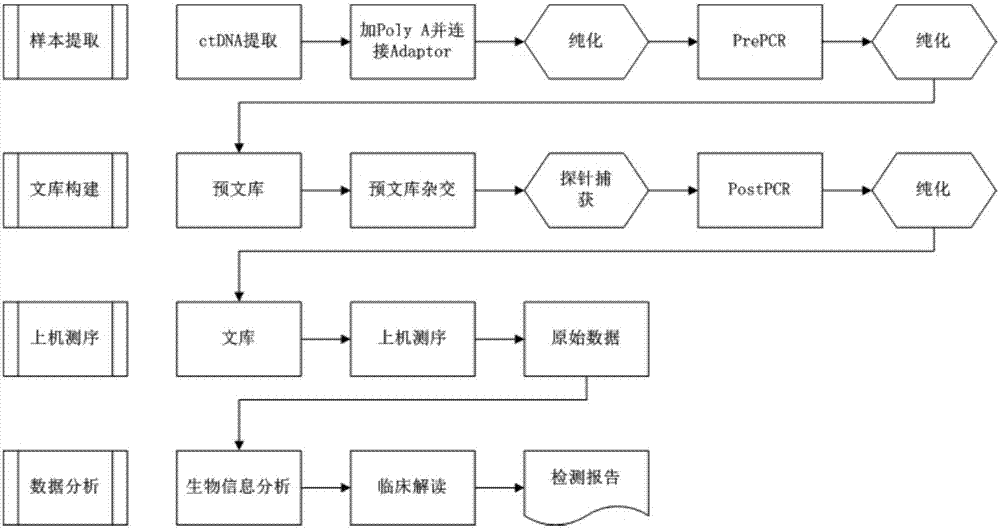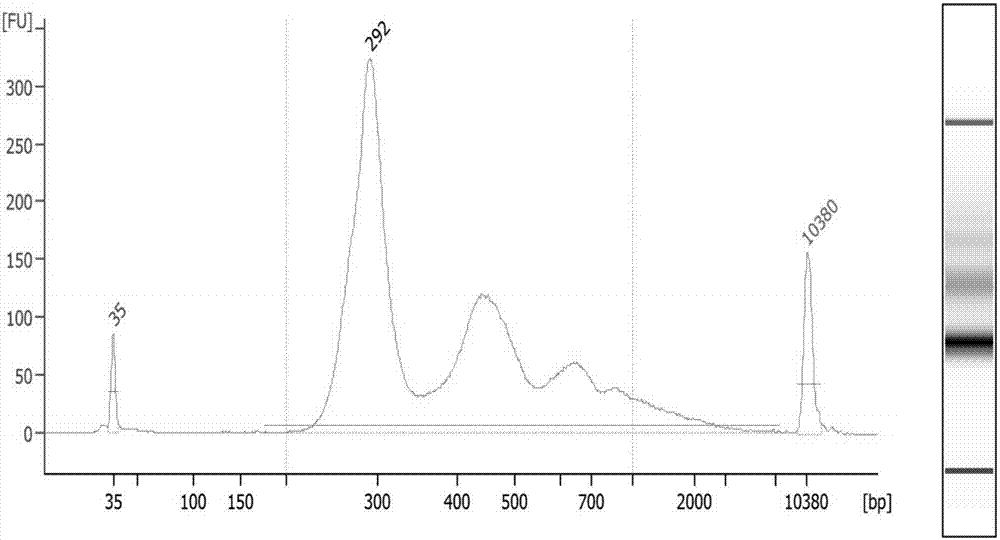Gene group and kit for diagnosing lung caner, and diagnosis method thereof
A lung cancer diagnosis and kit technology, applied in the fields of genetic engineering and biotechnology detection, can solve the problems of less tumor-related gene capture, missing gene mutation information, low sequencing sensitivity and accuracy, and optimize the detection process and improve the detection accuracy. Effect
- Summary
- Abstract
- Description
- Claims
- Application Information
AI Technical Summary
Problems solved by technology
Method used
Image
Examples
preparation example Construction
[0044] In a preferred embodiment of the present invention, the present invention provides the following preparation method, comprising:
[0045] (1) Preparation of DNA samples: Extract free DNA from plasma of different samples for library construction;
[0046] (2) End repair of the DNA sample: performing end repair on the free DNA obtained in step (1);
[0047] (3) Magnetic bead purification: use magnetic beads to purify the end-repaired DNA sample, preferably use AMPure XP magnetic beads for purification;
[0048] (4) Connect the A tail: connect the A tail to the purified product;
[0049] (5) Sample DNA connection adapter: connect the sample DNA product connected by the A tail to the connection adapter;
[0050] (6) performing library amplification on the sample DNA ligated by the adapter in step (5) to obtain a pre-capture PCR sample;
[0051] (7) Library hybridization: use specific probes to hybridize with PCR samples before capture to obtain ctDNA, and wash to obtain ...
Embodiment 1
[0061] according to figure 1 As shown in the flow chart, sample extraction, library construction, on-machine sequencing and data analysis were performed respectively. The specific process is as follows:
[0062] 1. Extraction of cell-free DNA
[0063] Using the ctDNA extraction kit (article number: 154022516, manufacturer: QIAGEN), the free DNA in the plasma of 4 different samples (these samples come from different tumor patients) can be extracted at the same time, and the DNA is quantified and dissolved in 50 μL ddH 2 In O, library construction was performed. The required reagent preparations are shown in Table 2.
[0064] Reagents required in Table 2
[0065] Reagent name
storage method
preparation method
Buffer ACL*
Buffer ACW1
room temperature
Buffer ACW2
room temperature
room temperature
Buffer ACB
room temperature
room temperature
Pr...
Embodiment 2
[0198] Taking CBR3 and CDA genes as examples, the method of multiplex PCR and the method of probe capture sequencing described in Example 1 were respectively studied for CBR3 and CDA genes, and library construction and sequencing were performed on the amplified and captured samples. The sample used was the product of cell-free DNA extraction from lung cancer plasma, and the initial concentration of cfDNA was 1.4 ng / μL.
[0199] Different primer sequences used in different exon regions of different genes in table 16
[0200]
[0201]
[0202] Using the NimbleGEN SeqCap Hybridization and Wash Kit kit, multiplex PCR (30-35 circles) was used to amplify the target fragment, and the concentration of the product was detected and the library was sequenced. At the same time, the high-throughput sequencing method of Example 1 was used to construct the library and perform capture sequencing. see results Figure 5-Figure 8 .
[0203] in Figure 5 and Image 6 For the statistica...
PUM
 Login to View More
Login to View More Abstract
Description
Claims
Application Information
 Login to View More
Login to View More - R&D
- Intellectual Property
- Life Sciences
- Materials
- Tech Scout
- Unparalleled Data Quality
- Higher Quality Content
- 60% Fewer Hallucinations
Browse by: Latest US Patents, China's latest patents, Technical Efficacy Thesaurus, Application Domain, Technology Topic, Popular Technical Reports.
© 2025 PatSnap. All rights reserved.Legal|Privacy policy|Modern Slavery Act Transparency Statement|Sitemap|About US| Contact US: help@patsnap.com



